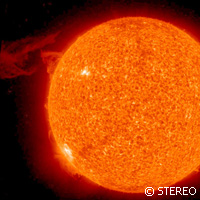Sun shines in STEREO probes' first 360° image
A pair of twin spacecrafts of the STEREO ('Solar terrestrial relations observatory') mission, launched in October 2006, has successfully reached its destination. For the first time ever, the spacecrafts captured a 360° view of our stellar neighbour. Over a four-year period, the spacecrafts travelled in opposite directions along the Earth's orbit en route to positions on opposite sides of the Sun. Experts from the CNRS (Centre National de la Recherche Scientifique), the Paris Observatory, and Paris-Sud 11, Pierre et Marie Curie, Paris Diderot and Toulouse 3 Universities are participating, with backing from the French-based government space agency CNES (Centre National d'Études Spatiales), in three of the four instruments on board the spacecrafts. Specifically, each STEREO spacecraft is fitted with telescopes tuned to capture four wavelengths of extreme ultraviolet radiation associated with activity on the solar surface. The US-based NASA (National Aeronautics and Space Administration) is proclaiming the unprecedented 360° panorama of the Sun's entire surface and its atmosphere that will bolster our understanding of solar dynamics and help improve space weather forecasts. The Sun, rather than burning with consistent force, cycles through phases of high activity and relative calm. STEREO helps to better monitor these phases, which usually last for an average of 11 years. The current cycle began in 2008, but only recently have solar scientists announced that the Sun is headed for its period of most turbulent activity. The first great explosive event that hurled billions of tonnes of charged particles at Earth was observed on 14 February. A part of the Sun has always remained hidden - until now. Although that unseen part rotated into view within a week or two, activity on the Sun can, on occasion, go global, with eruptions on opposite sides of the Sun triggering and feeding off of one another. With the new 360° view of the Sun, scientists will get a much better understanding of these phenomena, and a far earlier warning of imminent solar storms that pose a danger to satellites and astronauts. 'The Sun is a truly complex object which influences many aspects of our lives,' commented Richard Harrison from the Rutherford Appleton Laboratory, principal investigator for the UK instruments on STEREO. 'In the same way that you would not expect to understand the workings of the brain by studying just a small part of it, a global investigation into the nature of our star as a complete object is essential to understanding how it works.' The two spacecrafts will continue to move further apart, heading toward each other on the opposite side of the Sun from the Earth. This means that the full view provided by the two craft will quietly fade, leaving a growing region behind the Sun - on the Earth side - that they will not see. However, NASA's Solar Dynamics Observatory (SDO), launched a year ago, will remain fixed on the Sun, providing the missing piece of the puzzle.For more information, please visit: STEREO mission: http://www.nasa.gov/mission_pages/stereo/main/index.html NASA http://www.nasa.gov/ CNRS http://www.cnrs.fr/ Paris Observatory http://www.obspm.fr/obsparis.en.shtml Rutherford Appleton Laboratory http://www.stfc.ac.uk/About+STFC/48.aspx
Countries
France, United States



